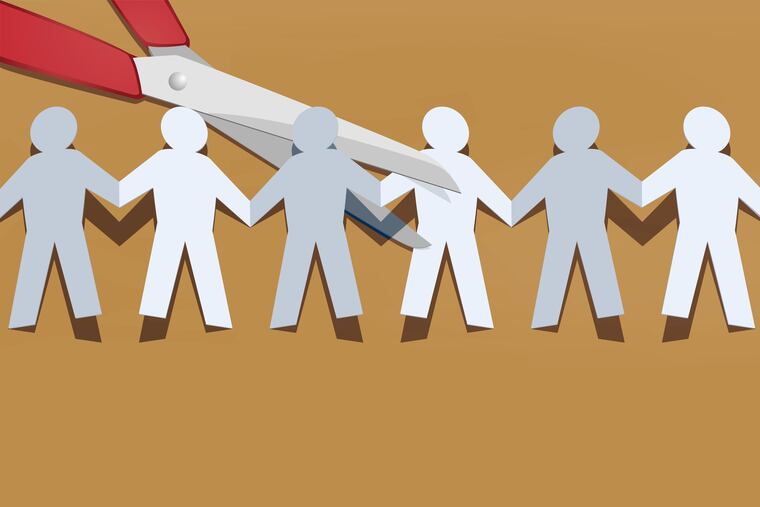My day care was my lifeline, and I was bereft when it closed. Thousands of Pa. families are facing the same fate.
Some of us are lucky enough to find a day care that provides the village all new parents desperately need. For them, the upcoming "childcare cliff" won't be so easy to recover from.

This week, we will reach the edge of the so-called childcare cliff, when the pandemic-driven infusion of federal funds to save the childcare industry runs out. An estimated one in three childcare programs in the country — or 70,000 — may have to close their doors.
In Pennsylvania alone, nearly 3,000 programs are set to shut down, leaving 150,000 kids with nowhere to go.
For many families, this may not be a big deal — they make a few calls, find another nearby place that has space for a new child, and after an adjustment period, everyone settles in to a new routine.
But I suspect that, for many families affected by the childcare cliff, it won’t be that simple.
That’s because day care isn’t always just a place to leave your kids during work. For many families, it is a community — one that is not easy to replace.
My day care was such a place, and for the rest of my life, I will feel lucky that I was a part of it.
» READ MORE: Congress must act to avert the looming childcare crisis | Editorial
Our day care wasn’t fancy. It was no more pricey than the already expensive cost of childcare in our area. But it was special.
The building was tucked into the side of a majestic, stone synagogue in Elkins Park, where the classrooms smelled of apples and honey in the fall, and matzo in the spring. My daughter’s first teacher had been there for decades and joined the staff after her children attended. Other teachers had the same story, including the principal, who worked there for 35 years. They loved this place and loved working with children, and it showed.
Kol Ami was more than the place where my daughter learned how to share toys, sing the alphabet, and sign her name. It was the village I needed.
For years, I was the poster child for the sandwich generation. My father, a widower, moved into a retirement facility days before my daughter was born. Several times per week, after work, I would pick her up from day care and drive to my dad’s, where I would push her stroller down the long hallways until we got to his door. She would sit on his lap, blinking at me as I ran around tidying his room, calling doctors to make his appointments, and showing him (for the millionth time) how to use the TV remote.
Their lives followed an opposite trajectory: as she learned basic skills — walking, talking — he was steadily unlearning. When she grew out of her stroller, he began needing a wheelchair, and she liked to push him down the long hallways of his facility. I would walk behind them, grateful to hear their giggles echo around me, trying to ignore the worries I had about both — Is she talking enough? Is he eating enough? — and feeling so, so tired.
I didn’t have the time to figure out how to provide all the early education that is so crucial to a child’s future. The teachers at Kol Ami taught her all the things I didn’t realize she would need for kindergarten, such as using scissors (who knew?). They taught me, too.
When my daughter refused to wear anything but the too-small shoes she loved even though the soles were worn through, her teacher pulled me aside and told me she needed new shoes. “I’m trying,” I moaned, “but she won’t wear anything else.” The teacher paused, looked me in the eye, and said, “You’re the parent.” The next day, I didn’t let my daughter leave the house until she was wearing different shoes.
After school or on weekends, parents would text each other a playground or house so we could meet up. We swapped tips on bedtimes, places to go with the kids, and how to take care of ourselves, even when we were surrounded by endless need. One of the many times my father was hospitalized for pneumonia, another mom agreed to take my daughter home with her kids after day care and texted me pictures of them happy-wrestling on the couch while I sat by my dad’s bed, waiting for the doctor to come in and tell me if he would survive.
At my daughter’s graduation from Kol Ami, the teacher had the kids dress as caterpillars, then asked families in the audience to close their eyes so the kids could swap their costumes for wings and become butterflies. It was the perfect illustration of my child’s transformation there. She entered a shy, silent 1-year-old who had never had a friend and emerged as a 5-year-old who sang all the words at the annual spring concert and was swarmed with greetings from her classmates when she returned after missing a day.
A few months after her graduation, COVID-19 hit. And Kol Ami’s day care closed for good.
For days, the parents exchanged bereft text messages. Most of our kids had already aged out of the place, but we felt so sad to know that other families wouldn’t have access to the same community we had enjoyed for so many years.
As I learn more about the coming childcare cliff, I wonder how many Kol Amis are on the chopping block. On the one hand, I hope every lost day care is easily replaceable for the affected families. On the other, I wish that every family finds a place like Kol Ami — for however long they’re lucky enough to have it.